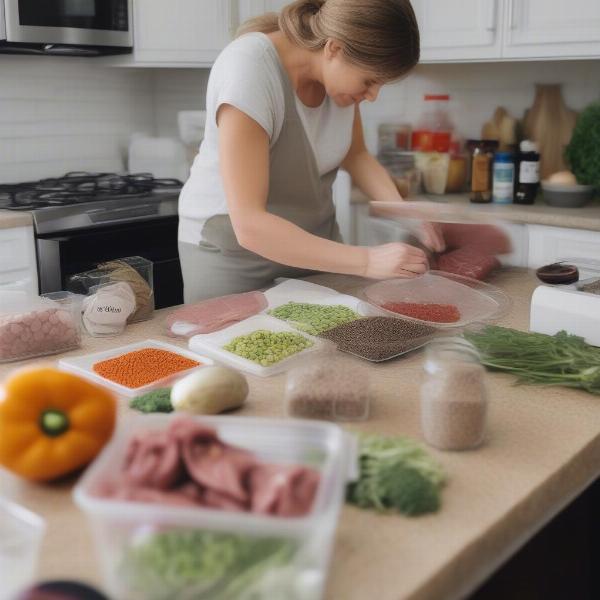A low phosphorus dog food diet is crucial for dogs with certain health conditions, particularly chronic kidney disease (CKD). Phosphorus is an essential mineral, but excessive levels can strain the kidneys, leading to further complications. Managing phosphorus intake through a specialized diet is a key component of managing these conditions and improving a dog’s quality of life. Choosing the right low phosphorus dog food can feel overwhelming, but understanding why it’s important and what to look for can make the process easier.
Why is Low Phosphorus Dog Food Important?
For healthy dogs, phosphorus plays a vital role in bone development, energy production, and cell function. However, when kidneys aren’t functioning optimally, they struggle to filter out excess phosphorus. This buildup can lead to a cascade of health problems, including weakened bones, mineral imbalances, and further kidney damage. Low phosphorus dog food helps alleviate this burden on the kidneys, allowing them to function more efficiently and slowing the progression of CKD.
Choosing the Right Low Phosphorus Dog Food
Selecting a low phosphorus diet for your dog should be done in consultation with your veterinarian. They can assess your dog’s specific needs and recommend an appropriate phosphorus level. When evaluating dog food options, look for foods specifically formulated for kidney support. These diets are typically lower in phosphorus and protein, as protein breakdown also contributes to phosphorus levels in the body. low phosphorus dog food
Reading the Label
Pay close attention to the guaranteed analysis on the dog food label. Look for the percentage of phosphorus listed, often expressed as “phosphorus (P)” or “max phosphorus.” Ideally, for dogs with CKD, the phosphorus level should be less than 0.5% on a dry matter basis. Calculating dry matter basis can be tricky, so don’t hesitate to ask your vet for help.
What Else Can I Do to Manage My Dog’s Phosphorus Levels?
Dietary changes are the cornerstone of managing phosphorus in dogs with CKD, but other strategies can further support kidney health. These include:
- Phosphate binders: Your veterinarian may prescribe phosphate binders, medications that help prevent phosphorus absorption in the gut. These are often given with meals.
- Regular monitoring: Regular blood tests are essential to track phosphorus levels and adjust treatment as needed.
- Hydration: Ensuring your dog drinks plenty of water helps support kidney function and flush out toxins.
- Managing other health conditions: Addressing any other underlying health issues can also contribute to better kidney health.
“Managing CKD requires a multifaceted approach. While low phosphorus food is vital, it’s crucial to work closely with your vet to implement a comprehensive treatment plan tailored to your dog’s individual needs,” advises Dr. Emily Carter, DVM, a veterinary nephrologist with over 15 years of experience.
Homemade Low Phosphorus Dog Food: Is It an Option?
While commercially available low phosphorus dog foods are generally recommended, some pet owners explore homemade diets. This approach requires careful planning and consultation with a veterinary nutritionist to ensure nutritional balance and avoid deficiencies. Getting the phosphorus levels correct in a homemade diet can be challenging, and imbalances can have serious consequences. low protein low phosphorus dog food
 Preparing Homemade Low Phosphorus Dog Food
Preparing Homemade Low Phosphorus Dog Food
Conclusion
A low phosphorus diet is a crucial component of managing kidney disease in dogs. By understanding why it’s important and how to choose the right food, you can play a vital role in supporting your dog’s health and well-being. Always consult your veterinarian for guidance on the best approach for your dog’s individual needs. Remember, managing phosphorus intake is just one piece of the puzzle, but it’s a significant step towards a healthier, happier life for your furry friend. dog food low in phosphorus
FAQ
- How do I know if my dog needs a low phosphorus diet? Your veterinarian can diagnose kidney issues through blood and urine tests and recommend dietary changes accordingly.
- Can I switch my dog to a low phosphorus diet suddenly? Gradual transitions are generally recommended to avoid digestive upset. Consult your vet for guidance.
- Are all low phosphorus dog foods the same? No, they vary in phosphorus content and other ingredients. Choose a food formulated for kidney support and follow your vet’s recommendations.
- What are the signs of high phosphorus in dogs? Signs can be subtle and often associated with underlying kidney issues. Consult your vet if you notice changes in your dog’s drinking, urination, appetite, or energy levels.
- Can too little phosphorus be harmful to my dog? Yes, phosphorus deficiency can also be problematic. Always follow your vet’s recommendations regarding dietary phosphorus levels.
- Are there any treats I can give my dog on a low phosphorus diet? Consult your vet for recommendations on low phosphorus treats or suitable alternatives.
- What if my dog refuses to eat low phosphorus food? There are strategies to encourage picky eaters, such as gradual transitions, mixing with familiar food, or warming the food. Discuss these with your vet.
ILM Dog is your trusted source for expert advice on dog care, nutrition, and breed-specific information. We provide practical guidance and valuable resources to help you make informed decisions about your dog’s well-being, from choosing the right breed to navigating health challenges like managing phosphorus levels. From puppy care to senior dog support, we offer insights into every stage of your dog’s life. For personalized guidance and expert advice, contact us at [email protected] or call us at +44 20-3965-8624. ILM Dog is committed to helping you provide the best possible care for your beloved canine companion.